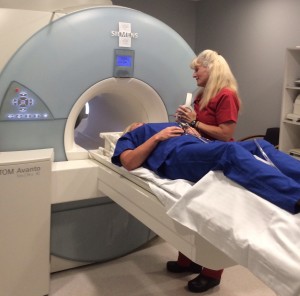Even though magnetic resonance imaging (MRI) has been around since the 1980s, it is still considered an advanced diagnostic imaging modality. MRI scanners produce detailed images of bones and soft tissue structures inside the body that provide valuable information to help diagnose illness or injuries, develop treatment plans, or prepare for surgery.
 However, the term “MRI” does not generally promote a warm, fuzzy feeling for the individual who needs to have this type of imaging, despite the fact it does not use ionizing radiation like a CT scan. Here are answers to the top five questions we are commonly asked about having an MRI.
However, the term “MRI” does not generally promote a warm, fuzzy feeling for the individual who needs to have this type of imaging, despite the fact it does not use ionizing radiation like a CT scan. Here are answers to the top five questions we are commonly asked about having an MRI.
1. Why is an MRI so noisy?
The sounds that come from the MRI scanner are actually vibrations. An MRI machine consists of one large electromagnet, called the main magnet, and three smaller electromagnets called gradients. To make an image, current is rapidly applied to the gradient coils which cause them to interact with the main magnet with great force. This creates the “banging” sound commonly associated with the machine. At Wake Radiology, we provide ear plugs and/or headphones to patients during the exam. While these often don’t completely cancel out all the noise, they do help. Patients wearing headphones may listen to their choice of music during the scan.
2. Why is there such a big concern about medical devices and metal in or on my body?
Most scanners used in medical imaging have a main magnetic field strength of 1.5 Tesla, which is approximately 30,000 times the earth’s magnetic pull. This powerful magnetic field is always on – even when images are not being taken – and is attracted to certain metals. This means that the closer an external object gets to the center of the magnet, the stronger the pull. This pull can cause objects to move suddenly and potentially create a projectile that can cause injury to anyone close by. Metal in the body can also be affected by the magnetic pull unless it is anchored in bone and is nonferrous. For this reason, any type of metal, including shrapnel, bullets, and metal flecks from grinding, that could be embedded in your body, especially the eyes, needs to be evaluated.
3. How long will the test take?
The actual exam time depends on the type of test ordered. Some exams are as short as 20 minutes while others are close to an hour. Each scan takes between 2-5 minutes. Just like taking a picture with a camera, if the patient moves, the images will be blurry and the entire scan will have to be repeated, which means a longer exam time.
4. What if I am nervous or anxious?
Our MRI staff and technologists are experienced caring healthcare professionals who answer any and all patient questions to help them relax and make it through the exam comfortably. At many Wake Radiology locations, if a patient becomes claustrophobic during the study, he/she may request IV sedation. This can be administered and monitored by a radiologist and given to a patient without an order from the referring doctor.
In order to receive sedation, the patient must have someone with them who is available to drive them home. The person driving must sign a consent form, so they have to be present when the patient begins the scan.
After receiving sedation – please be aware that you will not be able to drive, operate any heavy machinery, or make any important legal decisions for the remainder of the day. Even if you think the sedation has worn off, it is still in your system.
5. Will I have to get an IV?
Unless a patient is getting IV sedation, an IV is only started if:
- The MRI is ordered with IV contrast
- There is a clinical indication, or
- The radiologist recommends it.
IV contrast used in an MRI is called gadolinium. It is not an iodinated contrast, so patients will not get a warm, flush feeling that is often associated with receiving contrast during an x-ray or CT scan. In fact, some patients feel a little coolness when receiving MRI contrast because the fluid is stored at room temperature, not body temperature. Unless a patient has renal insufficiency, there are very few side effects with gadolinium.
Wake Radiology offers MRI exams in most of our offices in Raleigh, Cary, Chapel Hill, Garner, Wake Forest and Fuquay-Varina. Click here to learn more about MRI procedures.